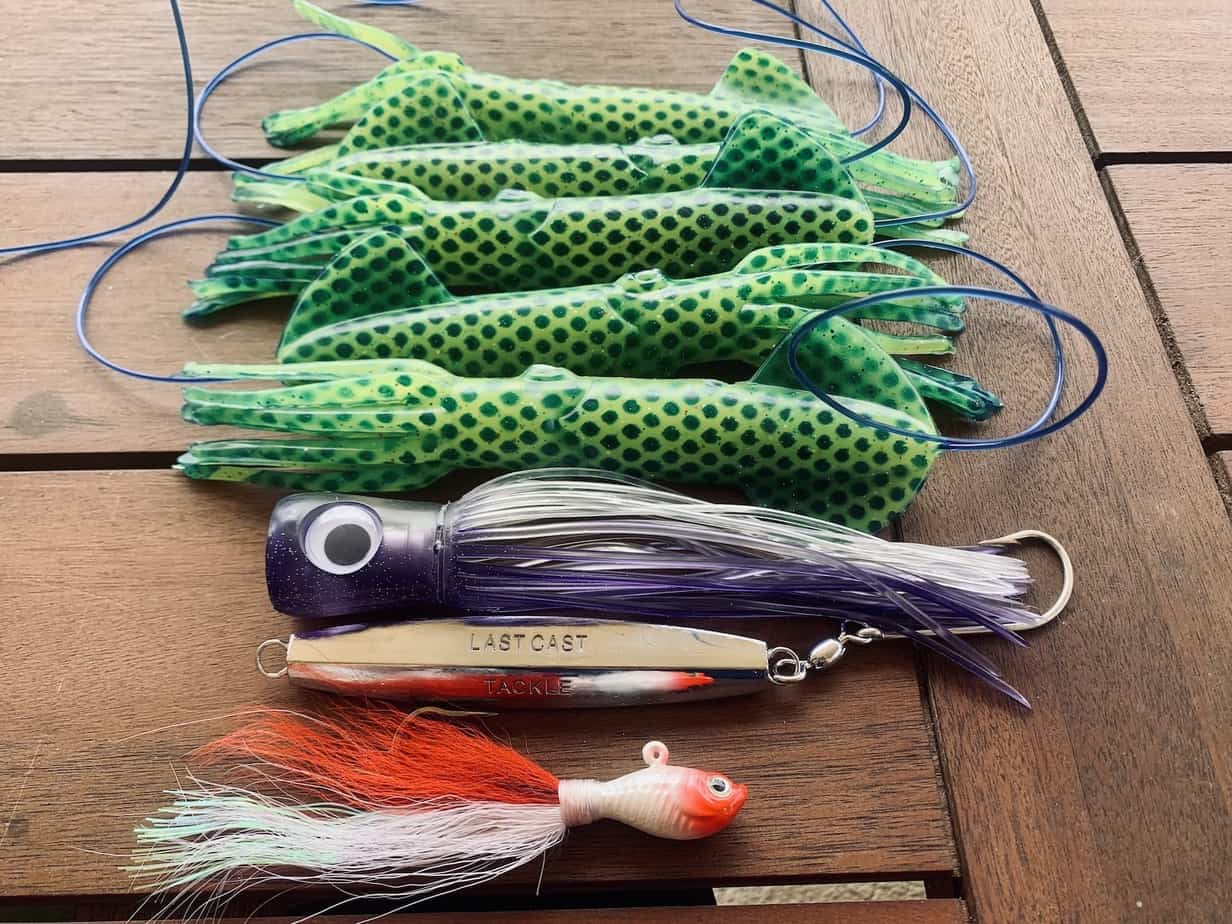Trolling Artificial Lures for Tuna
One of the most popular methods of fishing for tuna is trolling with artificial lures. Tuna are some of the fastest swimmers, so High Speed Trolling (HST) is commonly done. Trolling speeds of about 8 to 20 knots is considered High Speed Trolling. Trolling at these speeds can be tricky because lures tend to skip along the surface when moving this quickly. To keep the lures in the water, you’ll need to look for straight running lures, and plugs specifically geared towards high speeds.
1. Squid Daisy Chain with Chugger Lure
A daisy chain squid with a chugger lure in the back is a common lure presentation for tuna. The chugger at the back produces a lot of commotion to attract tuna from further away, and the daisy chain creates the illusion of several baitsquid to target. Since tuna will be shy if they see too much hardware, a hook is usually only included on the very last lure in the chain.
Mold Craft makes nice pre-rigged Squid Daisy Chains such as this one. There are two size options, a 9” daisy chain (5 squid, 300 lb mono, no hook) and a 6” daisy chain (7 squid, 300 lb mono, and no hook). I would go with the 9 inch hot pink and add a Mold Craft Super Chugger in purple, black and silver at the end. The hot pink color seems to work really well and I can see it pretty easily from the boat to check how its running. The purple, silver, and black super chugger has realistic eyes and attracts several species such as tuna, sailfish, and wahoo. The Super Chugger is listed as running well between 6 and 14 knots, so I’d stay under 14 knots for your High Speed Troll.
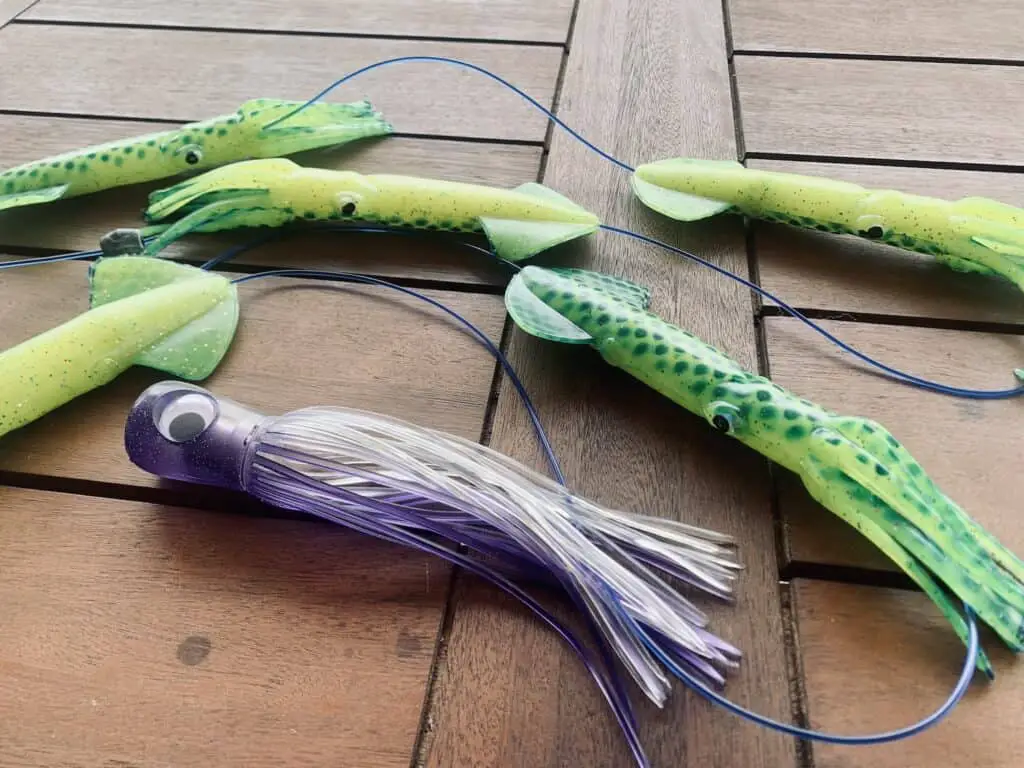
The Squid Daisy Chain and Super Chugger both come without a hook. I’d recommend adding a 7/0 O’Shaughnessy hook to your standard size Super Chugger for targeting tuna. The Gamakatsu hooks are strong which gives them the durability you’ll need for tuna. The O’Shaughnessy style hook has a longer shank to hold up against any toothy fish who might strike your lure. The length of the shank also helps to disguise the hook within the teaser part of the Super Chugger. The hooks are also extremely sharp to help easily set the hook in a fish’s mouth. These will dull over time, so make sure to check the sharpness and sharpen the hook if needed before your next outing.
2. Squid Spreader Bar
Although squid daisy chains work really well on tuna, sometimes you’ll want a cluster of squid together in the water. A squid spreader bar helps spread squid lures out in multiple directions, instead of one straight line. They spreader bar itself is typically made of a flexible wire that gives just enough stiffness to spread the lures in the water. They also normally come with storage bags to keep your bar protected and prevent tangles. The Fathom Offshore squid spreader bar also includes a snap swivel tucked in the last center squid so you can attach another squid with a hook, or bait such as a ballyhoo to the rig.
The Fathom Offshore spreader bar is 36 inches wide. This is intended for big tuna fishing and you’ll likely have an 80 class reel to pair with it. The hook is a size 8/0 which is appropriate for large tuna. I like to go with the green color on clear days and the black color on cloudy days. The spreader bar causes enough disturbance in the water to attract tuna. There are also spreader bars with birds at the front, however I notice that I have better luck with the spreader bars with only squids.
Trolling Natural Bait for Tuna
When trolling, natural baits such as large squid and ballyhoo can be particularly effective. They can be rigged up dead or alive and offer an additional realistic look and smell to attract fish. Often times, a ballyhoo will be added to a squid daisy chain by connecting the ballyhoo hook to the leader beneath the skirt of an artificial squid.
Chumming for Tuna
Chumming is commonly done as a technique to attract schooling tuna. Chumming is a process by which ground up baitfish mixed with seawater is dropped into the water downstream from your boat. Some anglers make chum themselves, or you can buy frozen boxes of chum. When going for tuna, you can’t go wrong with Menhaden chum which you can find at any baitshop, or even a place like West Marine. Butterfish, herring and mackerel work well too.
Once you see schooling tuna in your chum line, you can do some sight casting. Catching a big tuna on an artificial lure can be really fun and exciting. You can also throw out some chunked bait on a hook and line and catch them that way. The chunked bait hides the hook pretty well and can easily fool tuna.
You can also throw a dead bait, like a ballyhoo, into the chum line and let it drift with the chum. If the bait rises to the surface because the current is strong, you can add a sinker to help the bait get some depth. If the bait sinks too low because the current is too slow, you can add a piece of styrofoam to the belly to give it some buoyancy. Generally, when you’re doing this technique, your reel will be in freespool and you’ll be using your thumb to keep light pressure on the line. You’ll be able to feel when something takes your bait and you can quickly set the hook, push the drag lever forward and reel in.
This technique is normally done when the boat is drifting or anchored up. You can use your fish finder to find spots where there the bottom drops off and bait fish gather.
When targeting Yellowfin Tuna (YFT), chunking is commonly used instead of chumming. The idea is very similar to chumming, except its done with cubes of baitfish instead of ground fish with seawater. If you hook a chunk bait by burying the point of an 8/0 or 9/0 hook and tie it onto a 150-200 lb fluorocarbon leader, you can be very successful. I recommend tying your fluorocarbon leader to your main line with a barrel swivel since chunk bait tends to spin freely and you don’t want to twist your main line. It works best if the hooked chunk bait is drifting with non-hooked chunk bait. I have always used mackerel as my bait of choice for this technique.
Sight Casting & Jigging Lures for Tuna
The best lures to use for sight casting or jigging into a school a tuna, are plugs that pop or chug, large bucktail jigs, diamond jigs, and cedar jigs.
3. Yo-Zuri Mag Popper Lure
When I sight cast at schooling tuna in a chum line, I usually grab my Yo-Zuri Mag Popper lure in size 6-1/4 inches and the green mackeral color. I do a twitch, pause, retrieve action which causes the lure to pop up on the surface and causes a lot of commotion in the water. The flashy color further entices the tuna to bite.
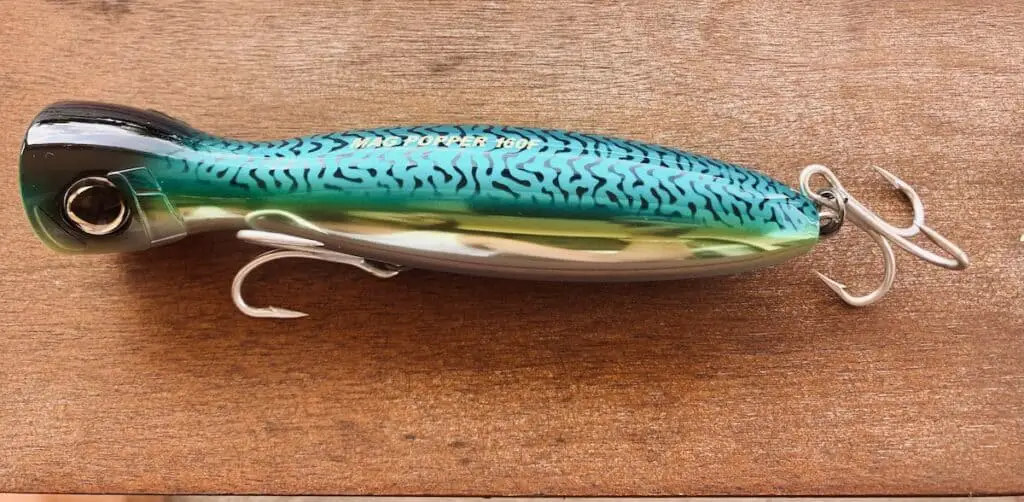
4. Yo-Zuri High Speed Vibe Lure
The Yo-Zuri High Speed Vibe lure is also very effective at attracting tuna. You can troll with it up to 12 knots, or you can cast or jig it. The lure has 2 treble hooks that are 3x strength to handle just about any size tuna. It works well on blackfin, yellowfin and Bluefin tuna. This lure has a tight wobble when trolled or retrieved at a steady rate. The Flying Fish color is my favorite. The length of the lure is 5 ¼ inches and it weighs just under 3 ounces. Although it may seem a little small, I’ve seen this lure produce bites when nothing else will. Like most offshore lures, it’s a little pricey, but I never leave home without it. I also tend to keep at least 2 in the boat just in case one gets bit off or lost. I like to cast this one and retrieve it at a fast pace for best results.
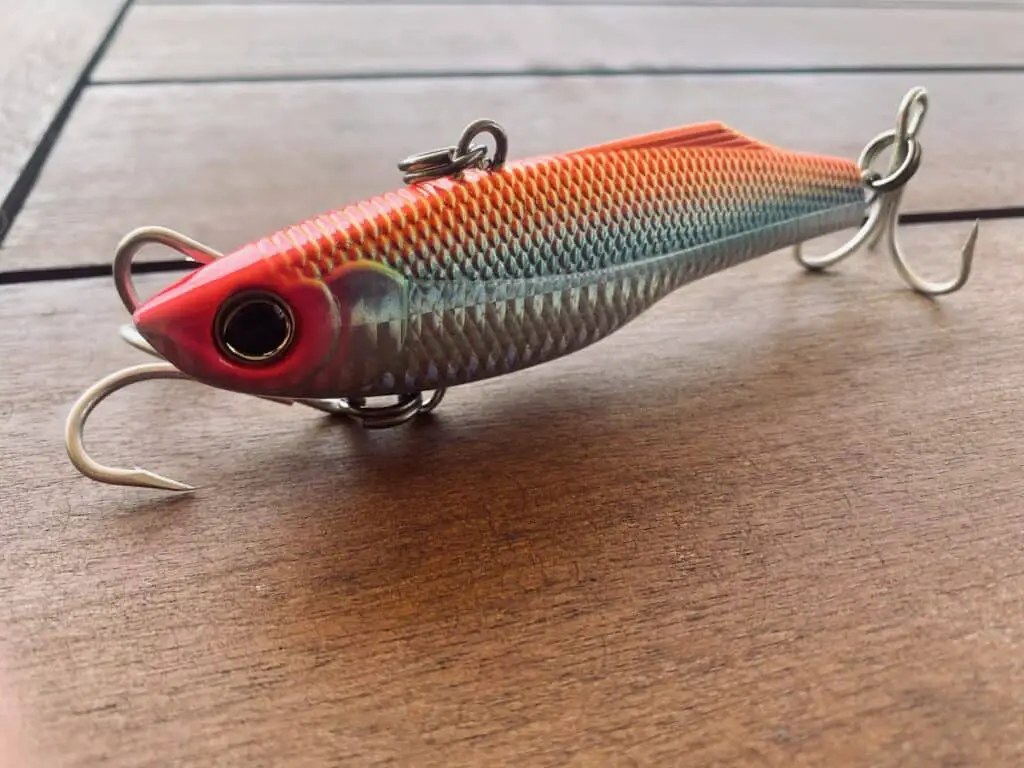
5. Bucktail Jig
For a bucktail jig, I would use no smaller than the 2 oz size that typically is rigged with a 7/0 hook. Tuna can be very large and have a strong bite, so you’ll need the larger size hook. For days when the current is stronger, you can use a 3oz, or up to an 8oz jig with an 8/0 hook. The 8/0 hook is still an appropriate size for tuna and the heavier weight will help the jig keep its depth on the retrieve, or sink to the bottom faster in a strong current. The feather tail on the bucktail jig helps to hide the hook and gives it a more lifelike appearance in the water. I tend to go for the bright colors like red and white, or hot pink for tuna.
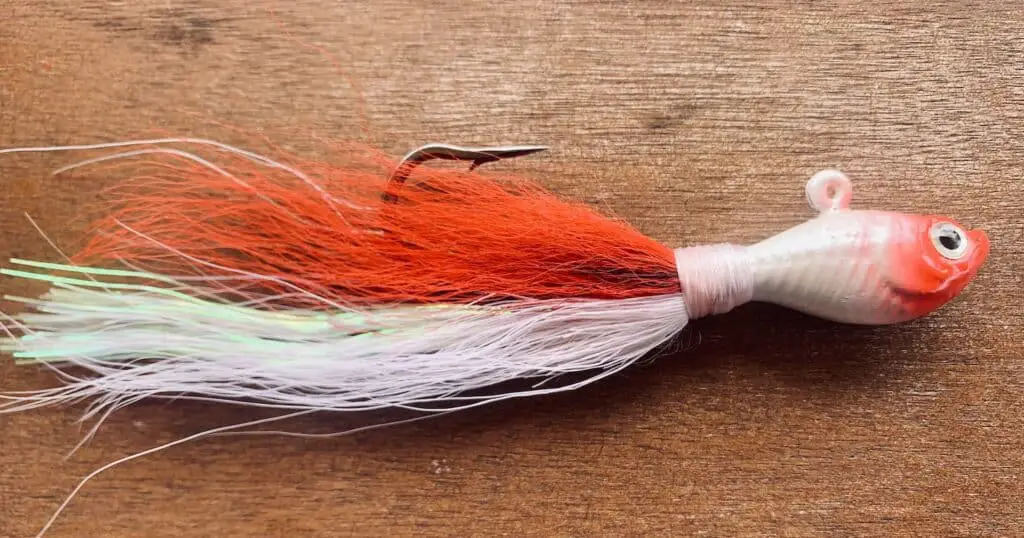
6. Cedar Plug
A cedar plug is loved by many for tuna fishing. Although it isn’t usually the coolest looking lure on the market, it produces just as well as some of the prettiest lures out there. You can buy a cedar plug, pre-rigged with a mono leader from TackleDirect. I like to run the cedar plug in my longest troll line. Although it doesn’t seem like there’s much to it, these cedar plugs have some of the best darting action to attract tuna. I wouldn’t underestimate a plain looking plug!
7. Diamond Jig
Diamond jigs are effective on tuna as well. They can be trolled, casted, or jigged. I have an 8oz size for Bluefin tuna fishing, which gets pretty heavy to cast and jig, so I usually only use it when I’ve got eyes on tuna. I use it offshore where there aren’t usually any weeds, so the treble hook doesn’t seem to snag on anything. Diamond jigs come in all sorts of sizes, colors, and configurations. Single J hook versions are available and are the better choice when fishing near weeds. There are versions with tubes attached on the end to mimic eels. These ones work very well when bottom jigging since a quick twitch off the bottom spreads out the sand and creates a very lifelike visual of an eel sporadically leaving bottom. There are colorful jigs and hammered metal diamond jigs. I prefer the simplicity of a smooth diamond jig, but I do fish other versions from time to time.
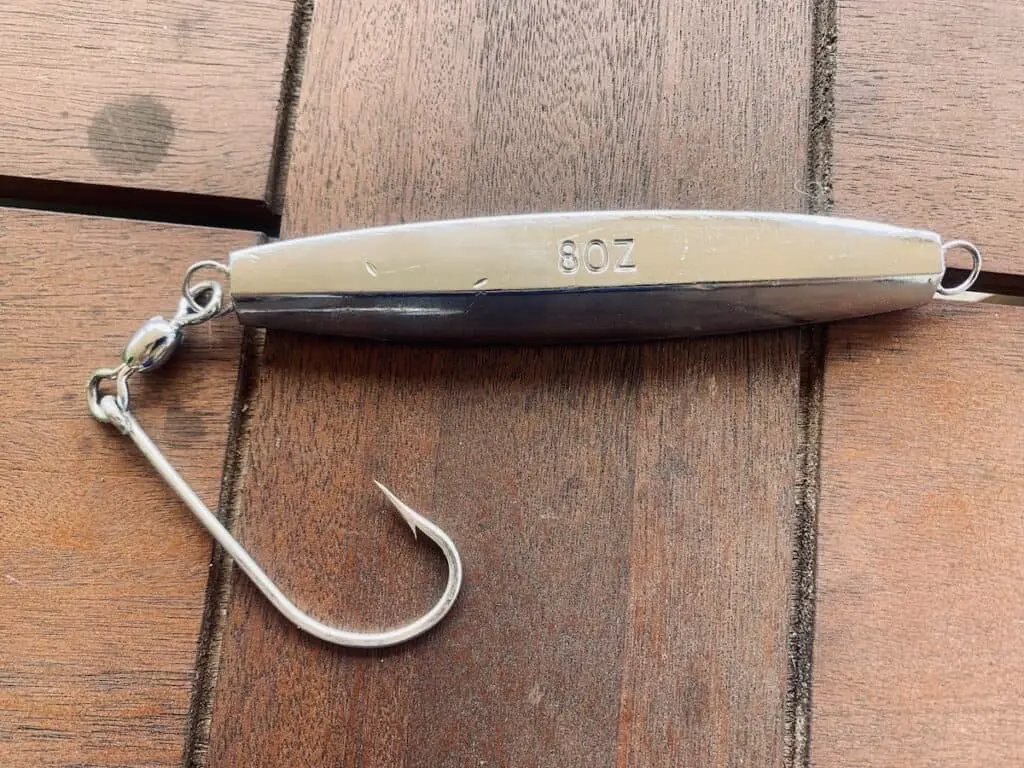
8. Nomad Buffalo Jig
If I’m doing deep vertical jigging, I tend to reach for my Nomad Buffalo style jig. This jig is weighted right in the middle which causes it to flutter on the fall. I saw the 8 oz Crimson Tide color and I had to have it since I went to school at the University of Alabama. The color patterns are great on these lures and the hooks are super strong to withstand the hookset of a big tuna. I like the assist hooks at the top of the lure since I pretty frequently hook fish on the upper hooks. I’d recommend getting some spare hooks since toothy fish can chew through it and I’d want to be able to keep fishing it if its getting bites.
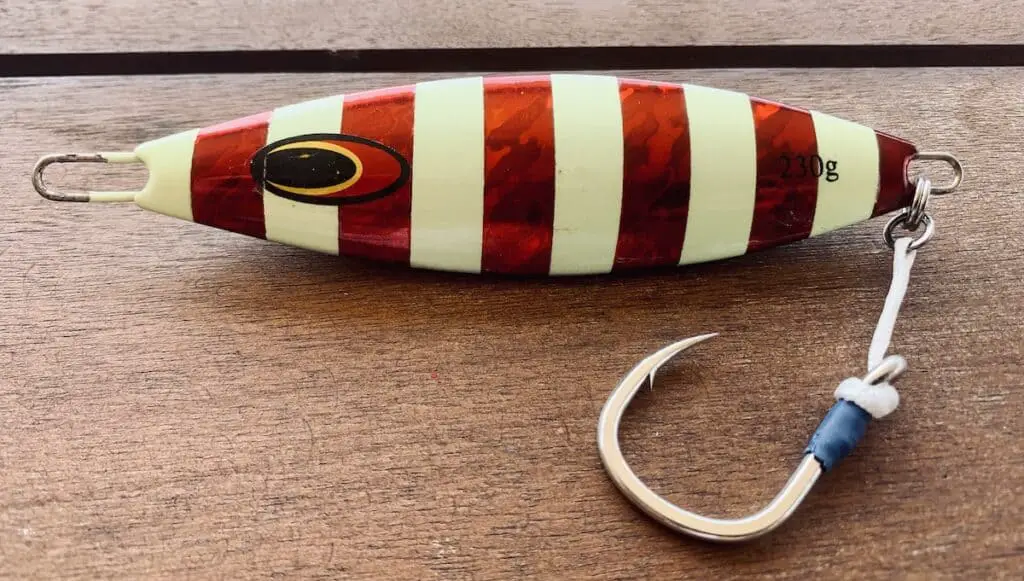
Tuna Rigging
Tuna rigs can vary quite a bit since tuna are found at pretty much all sizes. When I’m fishing nearshore and targeting blackfin or Bluefin around the 20-30 lb size, I’ll use a 15-30 class lever drag reel with hooks between 1/0 and 5/0 size. Tuna can be very line shy, so I’ll go for a fluorocarbon leader under 80 lb test.
If I’m targeting large Bluefin tuna over 60 lbs, I’ll use my heavier tackle. I’ll usually grab my 50 or 80 class Penn International to do the job. This is the reel I’ll use when I’ve got a 7/0 O’Shaughnessy hook on cut bait or a jig. At this higher lb class though, I feel like the tuna will see the leader no matter when the material is because the diameter is so large. I’ll usually go with mono for these setups so the line isn’t so heavy that it pulls the jig down. To read more about some of the reels I recommend for trolling, check out our article on trolling reels. For casting or jigging, I'd go with a baitcasting reel, which you can read more about here, or a spinning reel (article here).
I hope this article gave you helpful information about targeting tuna. Best wishes on your next trip! Tight lines, y'all!

